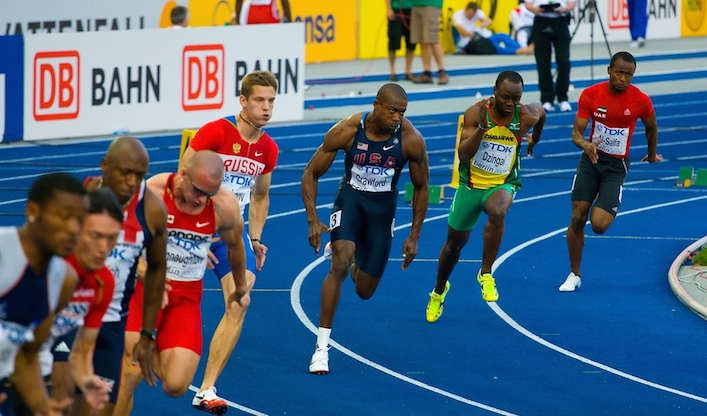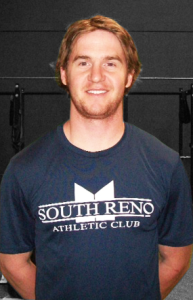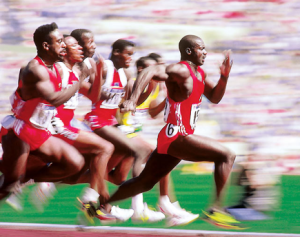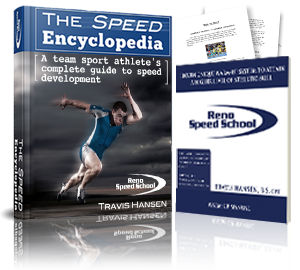 Following up on Monday’s post about sprint training, I wanted to interview Travis Hansen of the Reno Speed School to dig a bit deeper into his sprint training methodology. Enjoy!
Following up on Monday’s post about sprint training, I wanted to interview Travis Hansen of the Reno Speed School to dig a bit deeper into his sprint training methodology. Enjoy!
Travis, thanks for taking the time to be with us here today. Could you start by telling us a little bit about yourself?
 My pleasure Mike! I’ve been waiting for this opportunity for a long time now. I’ve been in the field of athletic development for a decade and logged nearly 20,000 hours of actual in the trenches training. Training and sports is literally all I know and it never gets old.
My pleasure Mike! I’ve been waiting for this opportunity for a long time now. I’ve been in the field of athletic development for a decade and logged nearly 20,000 hours of actual in the trenches training. Training and sports is literally all I know and it never gets old.
I’ve got a field related bachelor’s degree and various certifications, but I don’t think that really holds water to the time and effort spent in personal research to help optimize the athletes that I work with.
I currently operate a speed school in Reno, Nevada, I write for various sites online, and I’m on a major mission to get my book out to the performance training world.
What originally got you into the strength and conditioning/physical preparation field? Were you an athlete growing up?
Good question. My initial intrigue for strength and conditioning began when I was playing small college basketball down in the bay area 12 years ago. I was a big fish in a little pond back in high school and was riding high coming into college. I had some solid games at the collegiate level, but the biggest barrier for me was my athletic ability.
I vividly remember getting a back pick set on me and then my guy jetted past me and grabbed an alley-oop. I then quickly realized just how vital athleticism was for sport success, and the rest is history.
I read everything I could get my hands on that pertained to the subject, and bugged every expert in the field. I also spent 30k in one year on various educational resources (dvd’s, seminars, books, etc.). No joke.
Knowledge is power and in hindsight the investment was well worth it for me.
Ever since my dad put a mini basketball hoop in our backyard at the age of 4, I’ve been playing sports. I competed in Karate from the age of 8 to 12, and then got heavy into basketball, football, and baseball through junior high and high school.
Sounds like we’re pretty similar in that regard!
And taking that a step further, what led you down the path of sprint training?
I’ve always been drawn towards sprinting. It’s definitely one of the most athletic actions an athlete can possess and express.
I’ve also felt that there wasn’t anything comprehensive for team sport athletes that disclosed all of the practical scientific research specific to acceleration and speed development.
Lastly, I’ve always had 4.6 speed, so there came a point in time where I really wanted to practice what I was preaching and see what I was made of. Below is a video shot next to Denarius Moore of the Oakland Raiders who ran in the 4.37-4.43 range at his NFL Combine.
In case you are curious the timer on the screen was re-formatted from one of our fully electronic timing systems which runs 2-3 tenths slower than handheld timing. It’s definitely not my fastest, but just goes to show what the application of science and hard work can accomplish. I also want to note that I was all natural!
Very cool. Now that we’ve gotten through the fluff, let’s talk sprint training!
If you had to whittle your sprint philosophy down to a point or two, how would you describe it?
My philosophy is based on power development first and foremost. Technique and speed cannot and will not happen unless the athlete is powerful. Period.
Please do not take my word though. The research supports it.
Recent studies were conducted on Bolt and Lemaitre and they both indicated that the primary reason they were successful is because of their power output.
Once this foundation has been set, we just keep improving it to the highest degree possible. There are a dozen techniques that are important to speed, but they are and always will be secondary to power!
You see plenty of very fast athletes run with poor technique because they are powerful, but you will NEVER witness a technically sound athlete run fast without power.
You’ve obviously coached speed for quite some time now. What are some of the basic things you see done incorrectly with regards to sprint mechanics?
Some of the basic things that I see executed improperly with athletes is too much head and trunk movement.
I recall Bret Contreras citing some research that the level of movement at these segments is variable, and I need to look into this matter in more detail, but I’m referring to highly noticeable and vast amounts of rotation at these areas, which only leads to energy leaks and reduced activity at the prime movers: shoulders and hips.
 Also, demonstrating a neutral neck position will have effects distally at the hips and help remove anterior pelvic tilt.
Also, demonstrating a neutral neck position will have effects distally at the hips and help remove anterior pelvic tilt.
Ben Johnson is shown here (at right) with a packed neck while the rest of the group has their neck out of position in protraction.
And jumping off that question, what are some of the more in-depth things you see people doing wrong with their sprints?
Heel recovery is another common pitfall that I’ve noticed, especially in beginners.
Heel recovery is the path the foot takes as it exits the ground at pushoff, and swings back through the body back out in front of as it lands. Recovery adjusts as we start, accelerate, and then reach top speed, but the main deficiency with this technique is seen at top speed.
Athletes will extend the swing leg back behind them too much which creates massive inefficiency and far too much range of motion. Weak hip flexors, lack of awareness, and just straight poor speed seem to be the culprits here.
Also, poor stabilization of the elbow and elbow angle are common in athletes that I first start training. The shoulders should drive rather than the elbows. It could be all of the bicep curls, I don’t know.
Excellent – now let’s talk programming a bit. If you’ve got someone new who wants to start sprinting, where do you throw it into their overall program?
For beginners we will conduct our linear speed or change of direction training first, then our strength and core work, and then conditioning and the recovery phase.
Athletes come to me primarily to get faster, so we make that first priority once the warm-up/preparation phase is complete.
All of the beneficial effects of the warm-up period are now in full residual effect (CNS stimulation, metabolic signaling, coordination, etc.) and the athletes are primed to go hopefully set some PR’s.
Fatigue levels are also very low at the beginning of a session, and this factor is commonly referenced in the research and tends to correlate with speed development, so that is the scientific basis for sequencing speed work early in the workout.
On the other hand, if you have a more elite athlete that has to run a fast time for a test (i.e. 40, 60, etc.) how many days per week do you run them? And how do you typically break up their training program?
Great question, and I think this is definitely one of the things that still sets us apart from our competitors – 2 days at either supra-maximal or sub-maximal intensities.
In other words, 100+% or 90%.
Research shows that low frequency sprinting and jumping generate more favorable neuromuscular adaptations (fast twitch fiber conversion, increased cross sectional area, etc.) than moderate to high frequency approaches.
You could make a strong argument for a moderate approach (3 x per week) for raw beginners but it’s risky from an injury prevention standpoint.
A high-low approach over the course of month training cycle seems to work great for elite athletes. Meaning we run hard on weeks #1-3 and then buffer the intensity a bit on weeks #2-4 just to ensure that motivation and neural recovery are achieved.
Travis, you’ve been awesome and I really appreciate your time. Before I let you go, one final question.
Everyone in this game has made mistakes, myself included. What’s one mistake you’ve made with regards to coaching and/or programming sprinting, and how have you learned from that and gotten better as a coach?
This is probably the best question you have asked me, and I love the fact you can admit you aren’t perfect and you’ve made mistakes. We all have.
I’ve made tons of mistakes, and continually and obsessively revised my approach literally thousands of times over the course of the decade I’ve spent training until it felt right.
The biggest mistake that I’ve made in the context of speed development is doing too much with myself and my athletes.
I was extremely motivated and so were my athletes and we breached training volume principles and suffered temporary repercussions as a result.
This is where the “Dropoff Principle” comes in: Once times drop, STOP!
We were getting slower rather than faster and all of the symptoms of early overtraining began to emerge. It really is a matter of quality over quantity when it comes to speed training.
That’s a great point, and something I hope everyone will take to heart.
Travis, thanks a ton for being with us here today. Where can my readers find out more about you?
I’ve been fortunate enough to have written for T-Nation, Juggernaut, Undergroundstrengthcoach, but as of right now I’m only contributing for Jimson Lee over at Speedendurance.com, and Latif Thomas at completetrackandfield.com. Here are links that share some of my posts:
Speed Endurance – Travis Hansen
 Last but not least, I’ve written a very extensive manual on speed training, which you can find here:
Last but not least, I’ve written a very extensive manual on speed training, which you can find here:
MR: Awesome Travis – thanks again for your time!
